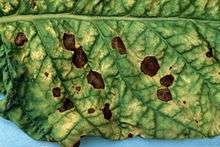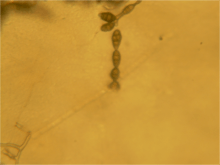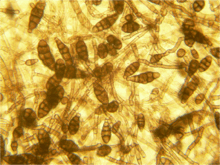Alternaria alternata
| Alternaria alternata | |
|---|---|
 | |
| Scientific classification | |
| Kingdom: | Fungi |
| Phylum: | Ascomycota |
| Class: | Dothideomycetes |
| Subclass: | Pleosporomycetidae |
| Order: | Pleosporales |
| Family: | Pleosporaceae |
| Genus: | Alternaria |
| Species: | A. alternata |
| Binomial name | |
| Alternaria alternata (Fr.) Keissl. (1912) | |
| Synonyms | |
|
Alternaria fasciculata (Cooke & Ellis) L.R. Jones & Grout (1897) | |
Alternaria alternata is a fungus which has been recorded causing leaf spot and other diseases on over 380 host species of plant. It is an opportunistic pathogen on numerous hosts causing leaf spots, rots and blights on many plant parts.
It can also cause upper respiratory tract infections[1] and asthma in humans with compromised immunity.
Disease cycle
There is no known teleomorph for Alternaria alternata. As a result, this pathogen propagates itself via asexual spores called conidia.[2] These conidia are produced in lesions on mature or dying leaves.[2] Their production can begin in as few as ten days after the first symptoms appear, and can continue for to up to fifty days.[3] A. alternata’s conidia disperse via air currents, and their release from the lesions can be triggered by rainfall, or even just a sudden drop in humidity.[3] When the conidium lands on a leaf, it will wait until the nighttime dew, and then germinate.[2] It can either enter through the stomata, or penetrate directly through the top of the leaf, using its appressorium, infecting the leaf within 12 hours.[2]
Identification
Teleomorph
Unknown
Anamorph
Conidiophore
- Pale brown to olive brown
- 25–60 x 3–3.5 µm
- Straight or flexuous
- Individual conidiophores arise directly from substrate forming bushy heads consisting of 4–8 large catenate conidia chains
- Secondary conidiophores are generally short and 1-celled


Conidia
- Pale brown to light brown
- Obclavate to obpyriform orellipsoid, short conical beak at the tip, or beakless
- Surface smooth to verruculose
- Size
- 20–63 x 9–18 µm in size
- (on PCA) mature conidia typically 10–30 x 5–12 µm
- Septa
- Several vertical and −8 transverse septa
- (on PCA) 3–7 transepta, 1–5 longisepta
- Chains
- Produced in an often branched, long chain more than 5 conidia.
- (on PCA) individual chains of 5–15 conidia, complex of branching chains may contain up to 50–60 conidia
References
- ↑ Wiest, Peter; Wiese, Kurt; Jacobs, Michael R.; Morrissey, Anne B.; Abelson, Tom I.; Witt, William; Lederman, Michael M. (August 1987). "Alternaria Infection in a Patient with Acquired Immunodeficiency Syndrome: Case Report and Review of Invasive Alternaria Infections". Reviews of Infectious Diseases. The University of Chicago Press. 9 (4): 799–803. doi:10.1093/clinids/9.4.799. JSTOR 4454171. PMID 3326127.
- 1 2 3 4 Timmer, Lavern. M., Tobin L. Peever, Zvi Solel, and Kazuya Akimitsu. "Alternaria Diseases of Citrus - Novel Pathosystems." Phytopathology Mediterranea 42 (2003): 99-112. Citrus Research and Education Center. Web. 21 Oct. 2015.
- 1 2 Dewdney, M. M. "Alternaria Brown Spot1." EDIS New Publications RSS. Web. 22 Oct. 2015.
External links
- Index Fungorum
- USDA ARS Fungal Database
- Japanese Fungi on Plants: Alternaria alternata
- Mycology Online: Alternaria alternata
- Alternaria alternata
- Alternaria alternata